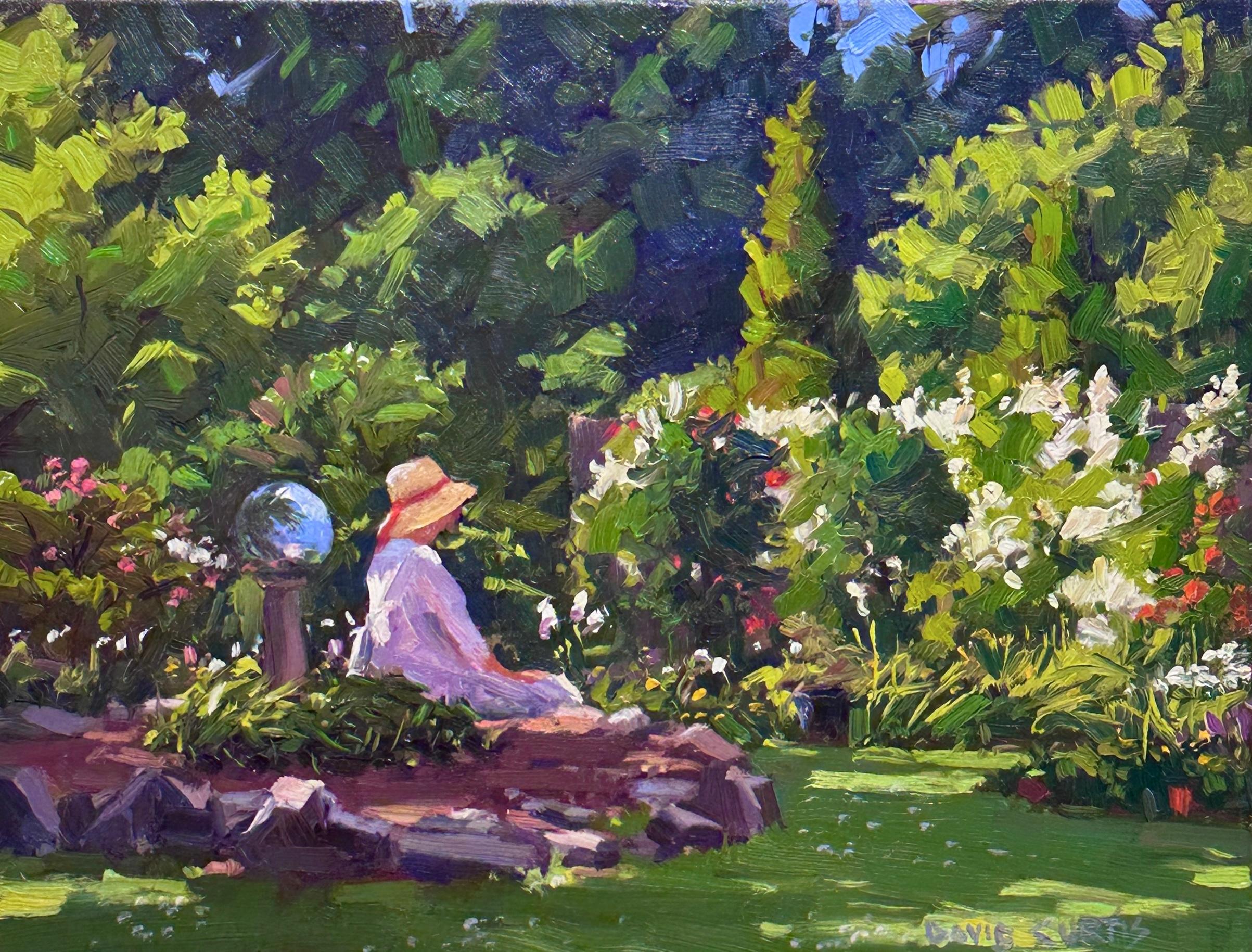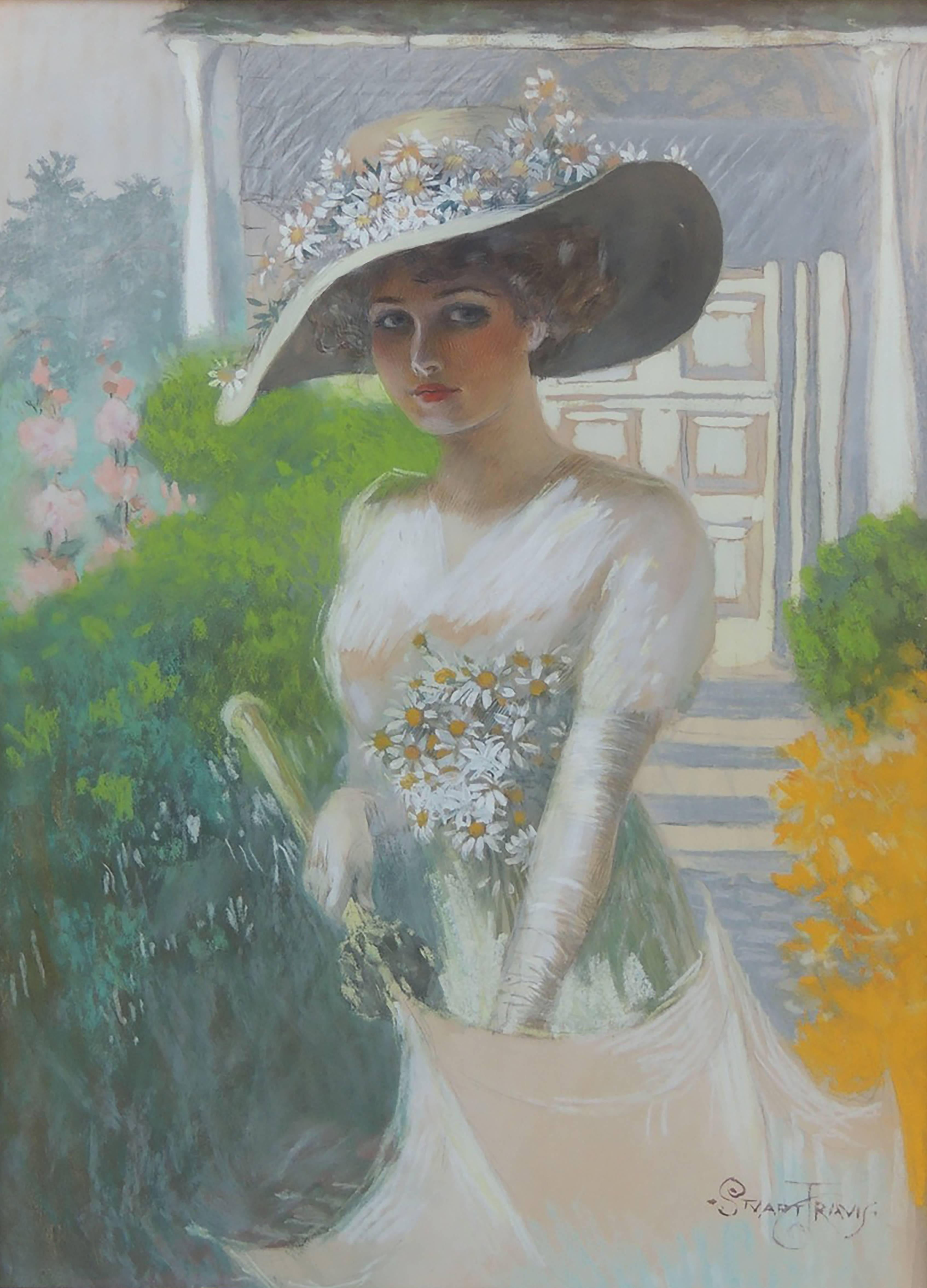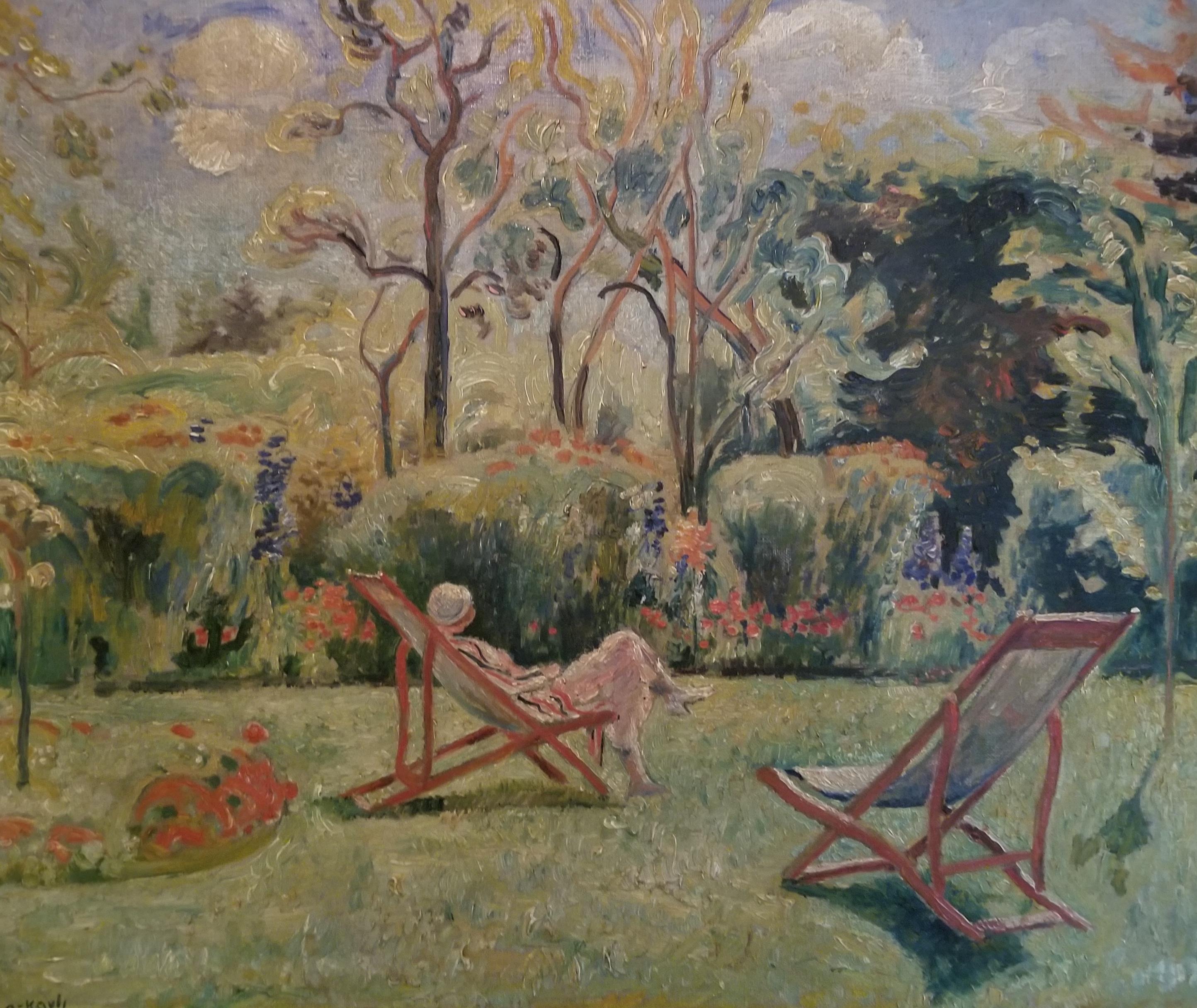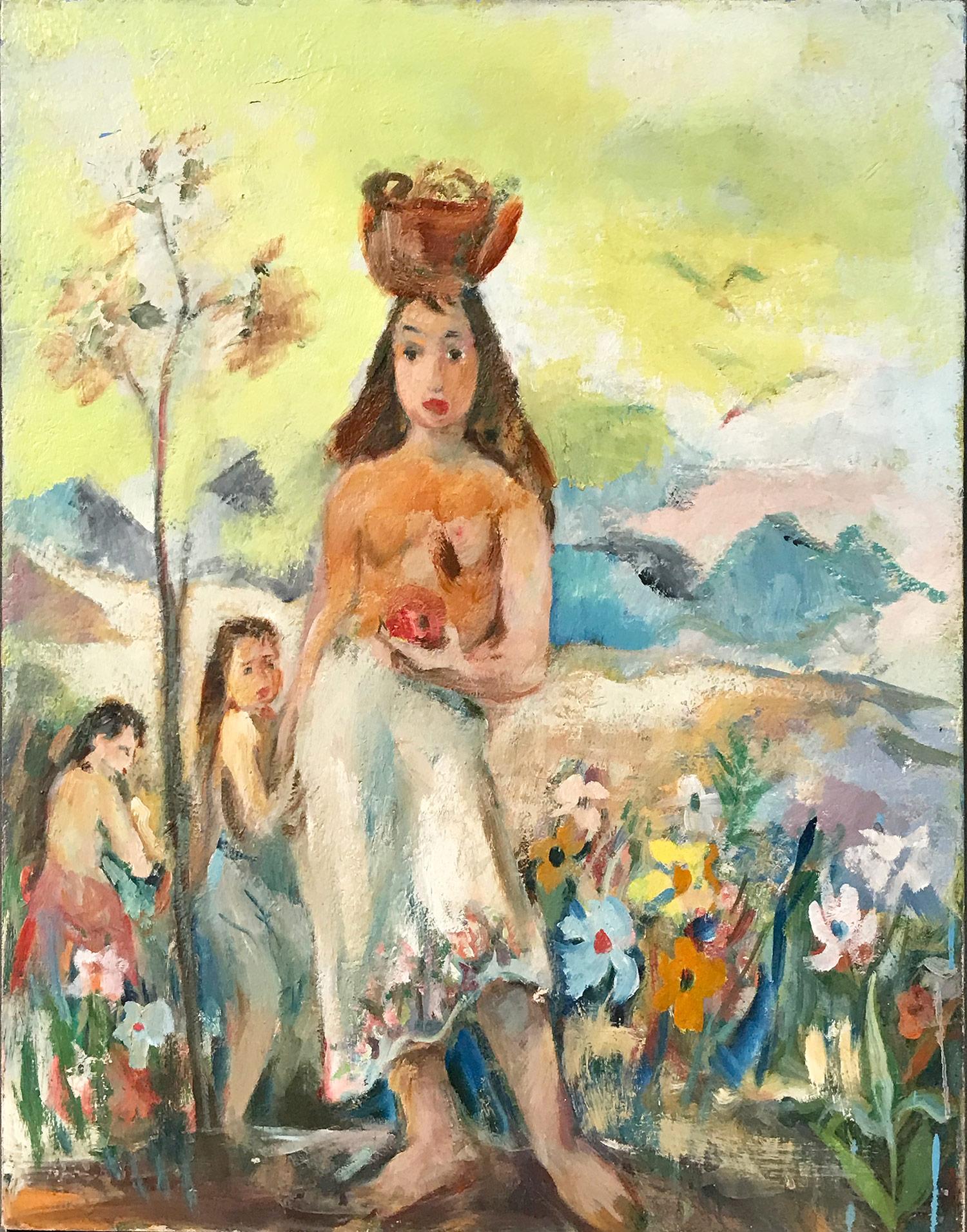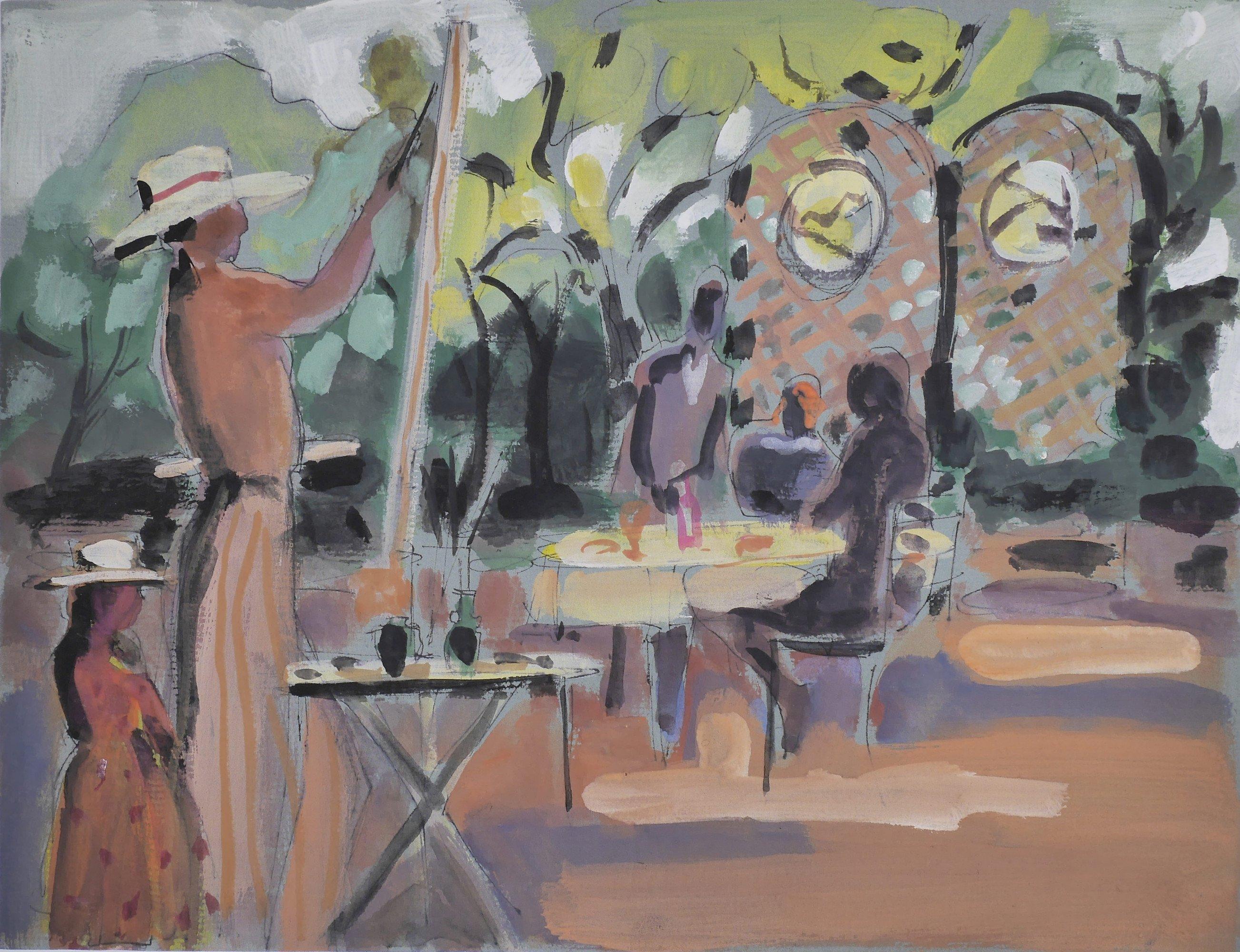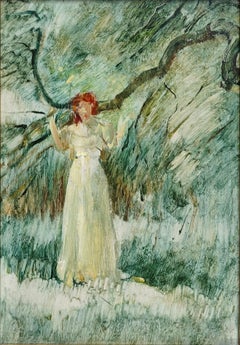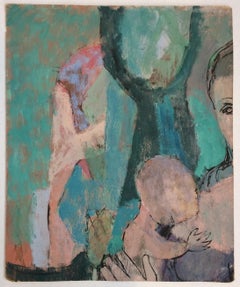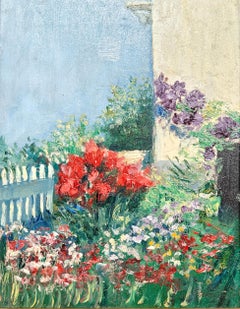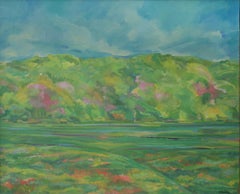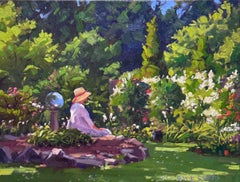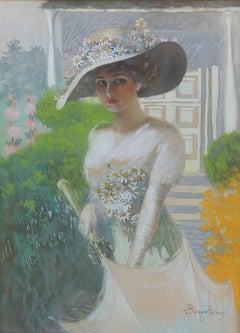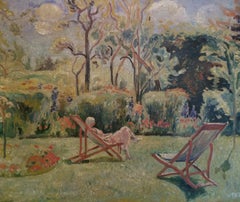Items Similar to "Woman Listening" Honore Sharrer, Magical Realism Landscape with Flora & Figure
Want more images or videos?
Request additional images or videos from the seller
1 of 8
Honore Sharrer"Woman Listening" Honore Sharrer, Magical Realism Landscape with Flora & Figure
$8,800
$11,00020% Off
£6,641.12
£8,301.4020% Off
€7,603.08
€9,503.8420% Off
CA$12,410.92
CA$15,513.6520% Off
A$13,625.64
A$17,032.0520% Off
CHF 7,108.53
CHF 8,885.6620% Off
MX$164,889.21
MX$206,111.5120% Off
NOK 89,094.33
NOK 111,367.9120% Off
SEK 83,950.28
SEK 104,937.8620% Off
DKK 56,754.93
DKK 70,943.6720% Off
About the Item
Honore Sharrer (1920 - 2009)
Woman Listening
Signed lower right
Caseine on paper
15 x 20 inches
Provenance:
Forum Gallery, New York
Private Collection
Honore Sharrer became celebrated as a prodigy of realism in 1944, when at age twenty-four, the Museum of Modern Art bought her study for a federal mural, Workers and Paintings (1943). At a time when most artists were moving into abstraction, she chose to paint small, meticulous panels, expressing her sympathy with the common people of this country.
Sharrer was born in West Point, New York. Her father was an army colonel, and her mother was an artist who had studied with Robert Henri. From her earliest years, Sharrer and her mother shared a companionable interest in art and spent weekends in the country painting and picnicking together. When she was fourteen, her father was stationed in Paris on the Ile St. Louis, and she attended her first life-drawing class at the Academie Colarossi with her mother. Much younger than the other students, she remembers being embarrassed by the nude model. Unlike the French girls at the lycee, Sharrer was free to roam the city unchaperoned, visiting the museums and absorbing the Old Masters at the Louvre.
When her father was transferred to San Diego, California, she attended the Bishops School, a private school in La Jolla. In her senior year, she won a $1000 prize from "American Magazine" in a national competition. Sharrer vividly remembers the powerful impression made on her by a fifteenth century painting by Hieronymus Bosch, "Christ Crowned with Thorns," at the San Diego Gallery of Fine Arts.
She identified with this traditional mode and decided to study at the Yale University art school, which was a stronghold of rigorous, traditional training before the arrival of Josef Albers and his Bauhaus-modern curriculum. After a year, Sharrer spent an additional year at the more free-wheeling California School of Fine Arts.
During World War II, she worked as a welder in a shipyard in Hoboken, New Jersey. There she closely observed the working-class types that she began to depict in her paintings. At a time when most artists were turning toward abstraction, Sharrer looked back to the realistic public art of the Federal Art Project of the 1930s, identifying strongly with its "human content and monumental form." She entered competitions for government post offices, and her mural study for the Worcester, Massachusetts, post office brought her to the attention of Lincoln Kirsten, who bought the study for the Museum of Modern Art.
After creating several small paintings, rendered like the works of Flemish and early Renaissance masters (Man at the Fountain (1948)), Sharrer embarked on an ambitious polyptych made up of five panels, entitled A Tribute to the American Working People (1951). Shown at Knoedlers Gallery in 1951, this work has recently been in the Sara Roby Foundation collection in New York. Although small in size, it is monumental in conception. Organized like a Renaissance altarpiece, A Tribute presents pictures of everyday America, -a worker in front of a factory, a schoolteacher and her class, a country fair.
Sharrer has explained, "I conceive of the people of this painting as individuals with petty pretensions and commercial vulgarities, but despite this crust of stereotype, they are the vital determining majority in which the cycle of birth, marriage, struggle, and death always seem to be pared down to elemental energy and simplicity of purpose". Four and a half years of arduous effort, and over four hundred photographs and sketches were applied to the research and execution of this work. She spent an entire day in an elementary school classroom just to study a particular kind of gesture, -of friendly play between a white child and a black child. The complex drawings were traced onto gesso panels and rendered in a technique so meticulous that painting one eye took her an entire day.
In addition to receiving major articles in Life and Art News, Sharrer exhibited in "Fourteen Americans" at the Museum of Modern Art and won various awards.
Between 1951 and 1969, during the wave of abstract art, she retreated into comparative isolation on her farm in Rochester, New York, where she lives and works in seclusion. She has been married since 1947 to Perez Zagorin, a history professor, and has one son.
Emerging after this hiatus, Sharrer showed larger satirical works, which were described in Arts (April 1969) as "devastating examples of social, political, and religious satire". "The Last Supper" is shown as the Mad-Hatters tea party. Lecherous old men, fully dressed monkeys, and fornicating dogs were part of the mélange, which was painted in a looser style.
In 1972, her painting "Leda and the Dwarf", won the Childe Hassam purchase prize from the American Academy of Arts and Letters. In 1978, "A Tribute to the American Working People" was sent to the U.S.S.R. in a major exhibition of American paintings selected by the Metropolitan Museum of Art.
- Creator:Honore Sharrer (1920, American)
- Dimensions:Height: 16 in (40.64 cm)Width: 21 in (53.34 cm)
- Medium:
- Movement & Style:
- Period:
- Condition:
- Gallery Location:New York, NY
- Reference Number:1stDibs: LU1841211234962
About the Seller
5.0
Platinum Seller
Premium sellers with a 4.7+ rating and 24-hour response times
Established in 2022
1stDibs seller since 2022
122 sales on 1stDibs
Typical response time: <1 hour
- ShippingRetrieving quote...Shipping from: New York, NY
- Return Policy
Authenticity Guarantee
In the unlikely event there’s an issue with an item’s authenticity, contact us within 1 year for a full refund. DetailsMoney-Back Guarantee
If your item is not as described, is damaged in transit, or does not arrive, contact us within 7 days for a full refund. Details24-Hour Cancellation
You have a 24-hour grace period in which to reconsider your purchase, with no questions asked.Vetted Professional Sellers
Our world-class sellers must adhere to strict standards for service and quality, maintaining the integrity of our listings.Price-Match Guarantee
If you find that a seller listed the same item for a lower price elsewhere, we’ll match it.Trusted Global Delivery
Our best-in-class carrier network provides specialized shipping options worldwide, including custom delivery.More From This Seller
View All"Into the Woods" Henry Prellwitz, Lyrical Woman In Wooded Landscape Painting
By Henry Prellwitz
Located in New York, NY
Henry Prellwitz
Into the Woods
Oil on board
11 1/2 x 8 3/4 inches
Henry Prellwitz studied art at the Art Students League of New York, where his chief mentor was Thomas Wilmer Dewing; he later became its director.[3] He also studied at the Académie Julian in Paris.
In 1892, he set up his studio in the Holbein Studios building on West 55th Street in Manhattan, where his future wife, the artist Edith Mitchill, also had a studio. They married in 1894 and had a son, Edwin.
By the mid 1890s, he was teaching portrait painting at the Pratt Institute, where one of his students was the Cubist artist Max Weber.
In 1899, Henry and Edith moved to the north shore of Peconic Bay on Long Island, where their artist friends Irving Ramsay Wiles and Edward August Bell were already established. They painted plein air paintings and also worked in adjoining studios at High House, their Peconic Bay home.
Prellwitz painted Impressionist and Tonalist waterscapes of Peconic Bay and allegorical figure paintings such as the 1904 Lotus and Laurel. He exhibited mainly on the east coast and at expositions like the St. Louis World's Fair, where he won a silver medal. He won the Third Hallgarten Prize from the National Academy of Design (NAD) in 1893 for The Prodigal Son, and his Venus won the Thomas B. Clarke Prize at the 1907 NAD exhibition for the best figure composition by an American citizen painted in the United States.
Both Prellwitzes disappeared into obscurity for several decades after their deaths in the early 1940s. Rediscovered in the 1980s, they have been called one of the best-kept secrets in art...
Category
Early 20th Century Modern Figurative Paintings
Materials
Oil, Board
“Woman with Rose” Lily Harmon, Female American Modernism Mid-century
By Lily Harmon
Located in New York, NY
Lily Harmon (1912 - 1998)
Woman with Rose
Ink and gouache on board
23 x 19 inches
Lily Harmon, was an artist who worked in portraiture, assemblage and book illustration, and whose ...
Category
Mid-20th Century American Modern Abstract Paintings
Materials
Ink, Gouache, Board
"A Sunny Corner" Eugenie M. Heller, Impressionist Garden Landscape In Bloom
Located in New York, NY
Eugenie M. Heller
A Sunny Corner, circa 1900
Signed lower right
Oil on board
10 1/2 x 8 1/2 inches
Eugenie M. Heller (1867 - 1952) was active/lived in New York, Massachusetts.
Heller studied with Weir, Whistler, Amen-Jean, Grasset and Rodin. Eugenie Heller...
Category
Early 1900s American Impressionist Figurative Paintings
Materials
Oil, Board
"Spring" Milton Derr, Lyrical Modernist Landscape, Bright Green and Blue Hues
Located in New York, NY
Milton Derr
Spring, 1982
Signed lower right; titled and dated verso
Oil on canvas
26 x 28 inches
Provenance
Acquired by descent from the artist to the present owner
Milton Derr wa...
Category
1980s American Modern Figurative Paintings
Materials
Canvas, Oil
"Pink Garden" Gerome Kamrowski, American Surrealist 1947 Expressive Abstraction
By Gerome Kamrowski
Located in New York, NY
Gerome Kamrowski
Pink Garden, 1947
Signed lower left
Watercolor on paper
22 x 30 inches
Gerome Kamrowski was born in Warren, Minnesota, on January 19, 1914. In 1932 he enrolled in ...
Category
1940s Surrealist Abstract Paintings
Materials
Paper, Watercolor
"MacMahan's Maine, " Howard Everett Giles, Figurative Landscape, Impressionism
Located in New York, NY
Howard Everett Giles (1876 - 1955)
MacMahan's Maine
Oil on canvas backed with board
30 x 30 inches
Signed lower right
Provenance:
Art Institute of Chicago
Christie's New York, December 8, 2011, Lot 2
Howard Giles spent most of his career in New York City, where he was an educator, magazine illustrator, and painter who espoused the theory of Dynamic Symmetry. He was born in Brooklyn, and as a young man worked in a New York railroad office. Financial support of a family friend allowed him to study at the Art Students League with H. Siddons Mowbray. In early 1910, he became an illustrator for Scribner's Magazine, and in 1912, on sketching assignment for Scribner's went to England. During World War I, he did illustration for Harper's Monthly Magazine, and many of his images were 'roaring twenties' genre and figure paintings.
In 1912, he began teaching life classes at the New York School of Fine and Applied Arts (later Parsons School of Design), and remained there until the late 1920s. During that time, he was also a part-time instructor at the Childs-Walker School in Boston, and accepted numerous invitations to lecture including at Carnegie Institute in Pittsburgh, Pennsylvania Academy of the Fine Arts, Detroit Institute of Arts and Wellesley College.
His initial painting style was Impressionism, but he grew increasingly interested in other scientific, aesthetic theories. He worked with Jay Hambridge from 1916 to 1919, applying Hambridge's theory of Dynamic Symmetry to his painting and his lecture topics. From 1922 to 1926, Giles also worked with and was influenced in his own painting by colorist theorist Denman Ross, who espoused a limited and related color palette. For many of his paintings, Giles used watercolor although he also painted in oil and pastels.
During the last years before his retirement when he moved to Woodstock...
Category
Early 20th Century American Impressionist Landscape Paintings
Materials
Oil, Panel
You May Also Like
David P. Curtis Figure Landscape Painting Woman in the Garden Scene
Located in Rockport, MA
Bask in the charm of a sunlit garden filled with vibrant blooms. A woman in a soft hat sits quietly, perfectly at ease among the lush greenery and flowers. The interplay of light and...
Category
20th Century American Impressionist Figurative Paintings
Materials
Oil
Woman sitting in the garden oil on canvas painting
By Juan Soler
Located in Barcelona, Barcelona
Canvas measures 61x50 cm.
Frameless
He was born in 1951. Under the direction of the master Pedro Bermejo, he began his artistic career, quickly highlighting and observing in his works an unusual mastery of drawing.
A very mature painter who has known how to stop time in all his works. His themes are preferably costumbristas although in his work the usual thing is to see eight century themes, with horse carriages, hats, umbrellas and still lifes.
Observing his work reminds us, by the subject, of Maestro...
Category
1980s Post-Impressionist Landscape Paintings
Materials
Canvas, Oil
$963 Sale Price
33% Off
Woman in the Garden
By Stuart Travis
Located in Fort Washington, PA
Date: 1907-1910
Medium: Pastel on Board
Dimensions: 22.00" x 28.00"
Signature: Signed Lower Right
Stuart Travis did many early Vogue magazine covers. Signed with an address on ...
Category
1910s Portrait Drawings and Watercolors
Materials
Pastel, Board
Lady in the Garden by the Bay
By Arne Kavli
Located in Saratoga Springs, NY
Signed lower left
Arne Kavli was born 27 May, 1878 in Bergen, and received his first restricted initiation into the world of artistic expression at the Tec...
Category
Early 20th Century Impressionist Landscape Paintings
Materials
Oil, Canvas
"In the Brush" Mid Century Oil Painting of Figures & Flowers Landscape
Located in New York, NY
A modernist depiction of figures in a landscape with a woman balancing a basket top her head. This native oil painting is reminiscent of post impressionistic artist Henri Rousseau. With colors of cobalts...
Category
1950s Impressionist Landscape Paintings
Materials
Oil, Canvas
Outdoor Garden Scene of Woman Painting, Late 20th C. Cleveland Female Artist
Located in Beachwood, OH
Algesa O'Sickey (American, 1917-2006)
Woman Painting
Watercolor and ink on green paper
Unsigned
9 x 12 inches
13.75 x 16 inches, framed
Born Algesa D’Agostino on June 4, 1917, Alges...
Category
Late 20th Century Figurative Drawings and Watercolors
Materials
Ink, Watercolor
More Ways To Browse
Tea Party
Vintage Welders
Vintage Country Fair
Mad Hatter Vintage
Honore Sharrer
Tea Party Vintage Dresses
Sailing Oil Painting
New York Bridge
Stone Arch
Acrylic Art Of Palm Trees
Antique Paintings City
Oil Paintings Of Charles
19th Century French Barbizon Landscape Painting
Gay Art
Helen Brown
Manchester City
Alpine Landscapes
Carmel By The Sea Painting
